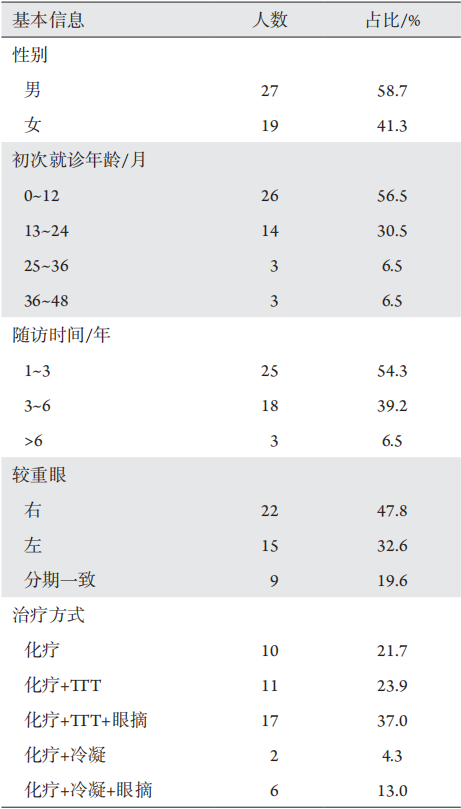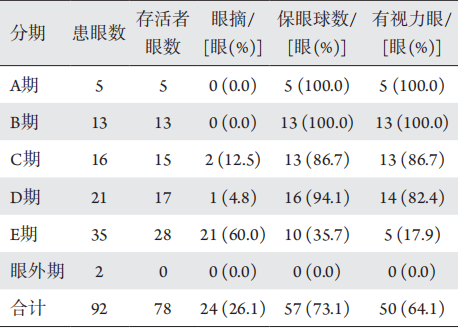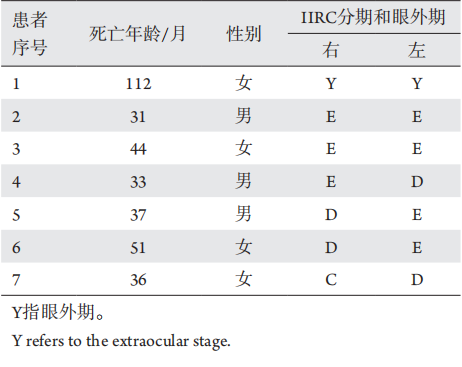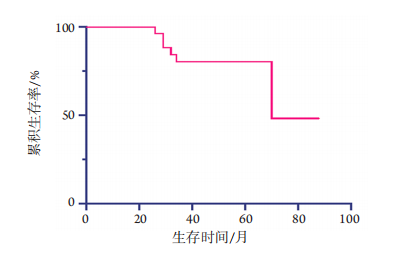1、Kivela T. The epidemiological challenge of the most frequent eye
cancer: retinoblastoma, an issue of birth and death[ J]. Br J Ophthalmol,
2009, 93(9): 1129-1131Kivela T. The epidemiological challenge of the most frequent eye
cancer: retinoblastoma, an issue of birth and death[ J]. Br J Ophthalmol,
2009, 93(9): 1129-1131
2、Shields JA, Shields CL. Intraocular tumors: an atlas and textbook[M].
Philadelphia: Lippincott Williams & Wilkins, 2008.Shields JA, Shields CL. Intraocular tumors: an atlas and textbook[M].
Philadelphia: Lippincott Williams & Wilkins, 2008.
3、Jagadeesan M, Khetan V, Mallipatna A. Genetic perspective of
retinoblastoma: From present to future[ J]. Indian J Ophthalmol, 2016,
64(5): 332-336.Jagadeesan M, Khetan V, Mallipatna A. Genetic perspective of
retinoblastoma: From present to future[ J]. Indian J Ophthalmol, 2016,
64(5): 332-336.
4、Sanders BM, Draper GJ, Kingeston JE. Retinoblastoma in Great Britain
1969-80: incidence, treatment, and survival[ J]. Br J Ophthalmol, 1988,
72(8): 576-583.Sanders BM, Draper GJ, Kingeston JE. Retinoblastoma in Great Britain
1969-80: incidence, treatment, and survival[ J]. Br J Ophthalmol, 1988,
72(8): 576-583.
5、Migdal C. Bilateral retinoblastoma: the prognosis for vision[ J]. Br J
Ophthalmol, 1983, 67(9): 592-595.Migdal C. Bilateral retinoblastoma: the prognosis for vision[ J]. Br J
Ophthalmol, 1983, 67(9): 592-595.
6、Abramson DH, Ronner HJ, Ellsworth RM. Second tumors in
nonirradiated bilateral retinoblastoma[ J]. Am J Ophthalmol, 1979,
87(5): 624-627.Abramson DH, Ronner HJ, Ellsworth RM. Second tumors in
nonirradiated bilateral retinoblastoma[ J]. Am J Ophthalmol, 1979,
87(5): 624-627.
7、Reese AB, Merriam GR Jr, Martin HE. Treatment of bilateral
retinoblastoma by irradiation and surgery; report on 15-year results[ J].
Am J Ophthalmol, 1949, 32(2): 175-190.Reese AB, Merriam GR Jr, Martin HE. Treatment of bilateral
retinoblastoma by irradiation and surgery; report on 15-year results[ J].
Am J Ophthalmol, 1949, 32(2): 175-190.
8、Roarty JD, Malean IW, Zimmerman LE. Incidence of second neoplasms
in patients with bilateral retinoblastoma[ J]. Ophthalmology, 1988,
95(11): 1583-1587.Roarty JD, Malean IW, Zimmerman LE. Incidence of second neoplasms
in patients with bilateral retinoblastoma[ J]. Ophthalmology, 1988,
95(11): 1583-1587.
9、Abramson DH, Beaverson KL, Chang ST, et al. Outcome following initial
external beam radiotherapy in patients with Reese-Ellsworth group Vb
retinoblastoma[ J]. Arch Ophthalmol, 2004, 122(9): 1316-1323.Abramson DH, Beaverson KL, Chang ST, et al. Outcome following initial
external beam radiotherapy in patients with Reese-Ellsworth group Vb
retinoblastoma[ J]. Arch Ophthalmol, 2004, 122(9): 1316-1323.
10、Gallie BL, Budning A, Deboer G, et al. Chemotherapy with focal
therapy can cure intraocular retinoblastoma without radiotherapy[ J].
Arch Ophthalmol, 1996, 114(11): 1321-1328.Gallie BL, Budning A, Deboer G, et al. Chemotherapy with focal
therapy can cure intraocular retinoblastoma without radiotherapy[ J].
Arch Ophthalmol, 1996, 114(11): 1321-1328.
11、Francis JH, Roosipu N, Levin AM, et al. Current treatment of
bilateral retinoblastoma: the impact of intraarterial and intravitreous
chemotherapy[ J]. Neoplasia, 2018, 20(8): 757-763.Francis JH, Roosipu N, Levin AM, et al. Current treatment of
bilateral retinoblastoma: the impact of intraarterial and intravitreous
chemotherapy[ J]. Neoplasia, 2018, 20(8): 757-763.
12、Shields CL, Mashayekhi A , Au AK , et al. The international
classification of retinoblastoma predicts chemoreduction success[ J].
Ophthalmology, 2006, 113(12): 2276-2280.Shields CL, Mashayekhi A , Au AK , et al. The international
classification of retinoblastoma predicts chemoreduction success[ J].
Ophthalmology, 2006, 113(12): 2276-2280.
13、Shields CL, Bas Z, Tadepalli S, et al. Long-term (20-year) real�world outcomes of intravenous chemotherapy (chemoreduction) for
retinoblastoma in 964 eyes of 554 patients at a single centre[ J]. Br J
Ophthalmol, 2020, 104 (11): 1548-1555.Shields CL, Bas Z, Tadepalli S, et al. Long-term (20-year) real�world outcomes of intravenous chemotherapy (chemoreduction) for
retinoblastoma in 964 eyes of 554 patients at a single centre[ J]. Br J
Ophthalmol, 2020, 104 (11): 1548-1555.
14、Bhargav A, Singh U, Trehan A, et al. Female sex, bilateral disease,
age below 3 years, and apprehension for enucleation contribute to
treatment abandonment in retinoblastoma[ J]. J Pediatr Hematol
Oncol, 2017, 39(5): e249-e253.Bhargav A, Singh U, Trehan A, et al. Female sex, bilateral disease,
age below 3 years, and apprehension for enucleation contribute to
treatment abandonment in retinoblastoma[ J]. J Pediatr Hematol
Oncol, 2017, 39(5): e249-e253.
15、Shields CL, Lally SE, Leahey AM, et al. Targeted retinoblastoma
management: when to use intravenous, intra-arterial, periocular, and
intravitreal chemotherapy[ J]. Curr Opin Ophthalmol, 2014, 25(5):
374-385.Shields CL, Lally SE, Leahey AM, et al. Targeted retinoblastoma
management: when to use intravenous, intra-arterial, periocular, and
intravitreal chemotherapy[ J]. Curr Opin Ophthalmol, 2014, 25(5):
374-385.
16、Shields CL, Fulco EM, Arias JD, et al. Retinoblastoma frontiers with
intravenous, intra-arterial, periocular, and intravitreal chemotherapy[ J].
Eye (Lond), 2013, 27(2): 253-264.Shields CL, Fulco EM, Arias JD, et al. Retinoblastoma frontiers with
intravenous, intra-arterial, periocular, and intravitreal chemotherapy[ J].
Eye (Lond), 2013, 27(2): 253-264.
17、Chen Q, Zhang B, Dong Y, et al. Evaluating primary intra-arterial chemotherapy versus intravenous plus intra-arterial chemotherapy
for advanced intraocular retinoblastoma[ J]. Cancer Chemother
Pharmacol, 2020, 85(4): 723-730.Chen Q, Zhang B, Dong Y, et al. Evaluating primary intra-arterial chemotherapy versus intravenous plus intra-arterial chemotherapy
for advanced intraocular retinoblastoma[ J]. Cancer Chemother
Pharmacol, 2020, 85(4): 723-730.
18、Menon BS, Juraida E, Alagaratnam J, et al. Chemoreduction for
intraocular retinoblastoma in Malaysia[ J]. J Pediatr Hematol Oncol,
2007, 29(1): 2-4.Menon BS, Juraida E, Alagaratnam J, et al. Chemoreduction for
intraocular retinoblastoma in Malaysia[ J]. J Pediatr Hematol Oncol,
2007, 29(1): 2-4.
19、Jubran RF, Villablanca JG, Krailo M, et al. A single-arm study of
systemic and sub-Tenon chemotherapy for Groups C and D intraocular
retinoblastoma: A Children's Oncology Group study (ARET 0231)[ J].
Pediatr Blood Cancer, 2020, 67(9): e28502.Jubran RF, Villablanca JG, Krailo M, et al. A single-arm study of
systemic and sub-Tenon chemotherapy for Groups C and D intraocular
retinoblastoma: A Children's Oncology Group study (ARET 0231)[ J].
Pediatr Blood Cancer, 2020, 67(9): e28502.
20、Gobin YP, Dunkel IJ, Marr BP, et al. Intra-arterial chemotherapy for
the management of retinoblastoma: four-year experience[ J]. Arch
Ophthalmol, 2011, 129(6): 732-737.Gobin YP, Dunkel IJ, Marr BP, et al. Intra-arterial chemotherapy for
the management of retinoblastoma: four-year experience[ J]. Arch
Ophthalmol, 2011, 129(6): 732-737.
21、Shields CL, Manjandav ida FP, Lally SE, et al. Intra-ar terial
chemotherapy for retinoblastoma in 70 eyes: outcomes based on the
international classification of retinoblastoma[ J]. Ophthalmology, 2014,
121(7): 1453-1460.Shields CL, Manjandav ida FP, Lally SE, et al. Intra-ar terial
chemotherapy for retinoblastoma in 70 eyes: outcomes based on the
international classification of retinoblastoma[ J]. Ophthalmology, 2014,
121(7): 1453-1460.
22、Vajzovis LM, Murray TG, Aziz-sultan MA, et al. Supraselective intra�arterial chemotherapy: evaluation of treatment-related complications in
advanced retinoblastoma[ J]. Clin Ophthalmol, 2011, 5: 171-6.Vajzovis LM, Murray TG, Aziz-sultan MA, et al. Supraselective intra�arterial chemotherapy: evaluation of treatment-related complications in
advanced retinoblastoma[ J]. Clin Ophthalmol, 2011, 5: 171-6.
23、Venturi C, Bracco S, Cerase A, et al. Superselective ophthalmic artery
infusion of melphalan for intraocular retinoblastoma: preliminary results
from 140 treatments[ J]. Acta Ophthalmol, 2013, 91(4): 335-342.Venturi C, Bracco S, Cerase A, et al. Superselective ophthalmic artery
infusion of melphalan for intraocular retinoblastoma: preliminary results
from 140 treatments[ J]. Acta Ophthalmol, 2013, 91(4): 335-342.
24、Bianciotto C, Shields CL, Iturralde JC, et al. Fluorescein angiographic
findings after intra-arterial chemotherapy for retinoblastoma[ J].
Ophthalmology, 2012, 119(4): 843-849.Bianciotto C, Shields CL, Iturralde JC, et al. Fluorescein angiographic
findings after intra-arterial chemotherapy for retinoblastoma[ J].
Ophthalmology, 2012, 119(4): 843-849.








